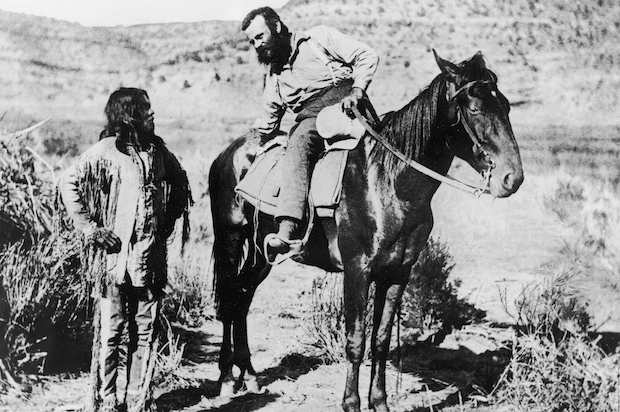This book begins with Simon Winchester becoming a US citizen two years ago: ‘I swore a solemn oath before a federal judge on the afterdeck of the warship USS Constitution in Boston Harbor.’ On several occasions during the 450-plus pages that follow, I wondered if becoming a US citizen had driven him a bit mad.
Winchester’s aim is to write about the explorers, geologists, cartographers, topographers and entrepreneurs who transformed America from a scattering of far-flung outposts into a cohesive whole. Nothing odd about that — but the way in which he has gone about it certainly is. For reasons that are never entirely clear, Winchester has chosen to divide up his narrative into five categories according to the five classical elements: wood, earth, water, fire and metal. He writes:
It suddenly seemed to me that the five elements could be a logical way of placing into context the basic themes behind the making and joining together of the United States.
The trouble with this idea is that it comes unstuck almost immediately. He kicks off with Jefferson, who became obsessed with sending out an army of cartographers to survey America. So, where’s the wood? Well, it turns out that ‘Thomas Jefferson was a man with a lifelong fascination with trees.’
Stone me, you just might be thinking, that’s a bit tenuous — in which case you’d better hold on tight; there’s plenty more where that came from. In the section on water, Winchester writes, reasonably enough, about canals, but then has to make a desperate lunge to get to the railways.
It is an unassailable physical fact that the invisible and very hot gas known since the 11th century as steam occupies 1,600 times the volume of the water from which it is made.
It’s also an unassailable fact that the invisible gas known since long before the 11th century as hot air pours forth from Winchester’s pen in limitless quantities. Matters aren’t helped by the fact that he has chosen to put a lot of himself into the narrative. On one occasion, looking for a giant cleft in Montana, known as the Gates of the Mountains, he’s given a lift in a boat by a man called Jeff and his son Jason. Grateful for their help, Winchester decides to send them a present, but can’t think what to buy. Then inspiration strikes: ‘I decided to buy a copy of one of my recent books and send it to Jeff and Jason as a gift for their kindness.’ And after signing it ‘suitably’, he sends it off.
While this may catapult him straight to the top of the authorial immodesty league, it adds little to the story. But amid the windiness and the bigging-himself-up there are some remarkable tales here — of men like the explorers, Lewis and Clark, who strode off into the interior armed with gift-boxes with which to pacify the local Indians. Included were presidential medals (second and third class only), scissors, mirrors and a comb — the intention plainly being to turn them all into trainee hairdressers. In fact the Indians they encountered weren’t so much peaceable as supine, ‘offering their wives as favours to the visitors’.
Other Indians, however, fared less well. Another band of 19th- century topographers, travelling through the lower Colorado River, came across an Indian of ‘such staggering ugliness that one of their number, a German attached to the party, voted to kill him, pickle him in alcohol and take him back for forensic inspection.’ Eventually, more sober voices talked him down, and the man was allowed to go on his way.
I also liked the account of how the one-armed John Wesley Powell came across an enormous hole in the ground in Arizona in 1876. Originally, he called it the Big Canyon. Then, five years later, he decided that the Grand Canyon sounded more dramatic.
But however strange or stirring these stories, it doesn’t do them any favours to relate them in a prose style that reads like God let loose on a thesaurus. Land, we learn, is ‘an immovable part of the eternal fabric of our celestial body’. And what is one to make of this similarly grandiloquent and even more nonsensical sentence?
Here, too, aboriginal peoples once bestrode every inch of the river’s banks — and for no tribe did the river itself serve as an entity that fully divided them.
When Lewis and Clark’s expedition reached the coast of Oregon in 1805, having walked from one side of America to the other, they were covered in boils, had dysentery, lacerated feet, rheumatism, malaria, frostbite and gonorrhoea. It’s hardly comparable, I know, but by the time I got to the end of The Men Who United the States, I wasn’t feeling too hot myself.






Comments